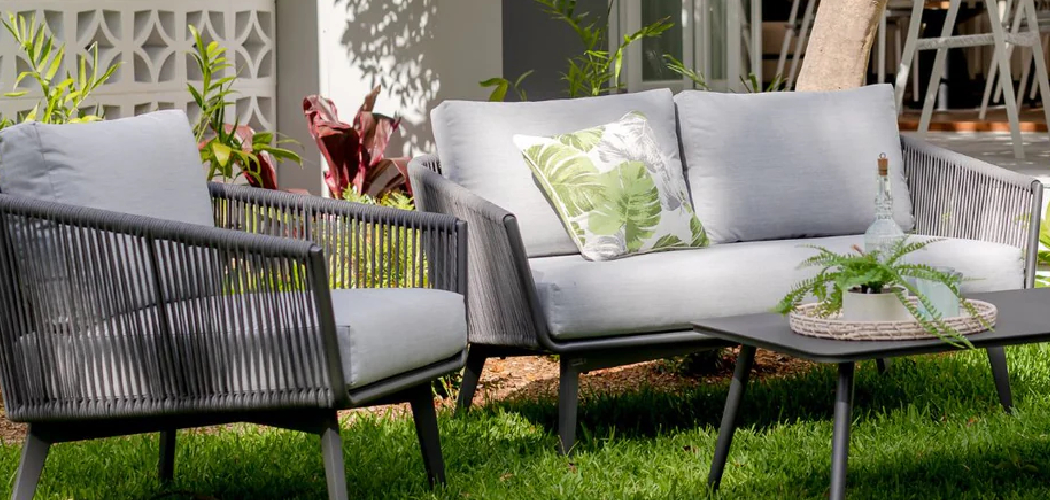Spring and summer bring warm weather and the opportunity to enjoy outdoor spaces, but they also bring an unwelcome guest: pollen. For many, pollen is not just an allergy trigger but also a nuisance that settles on patio furniture, leaving it covered in a fine, yellowish dust.
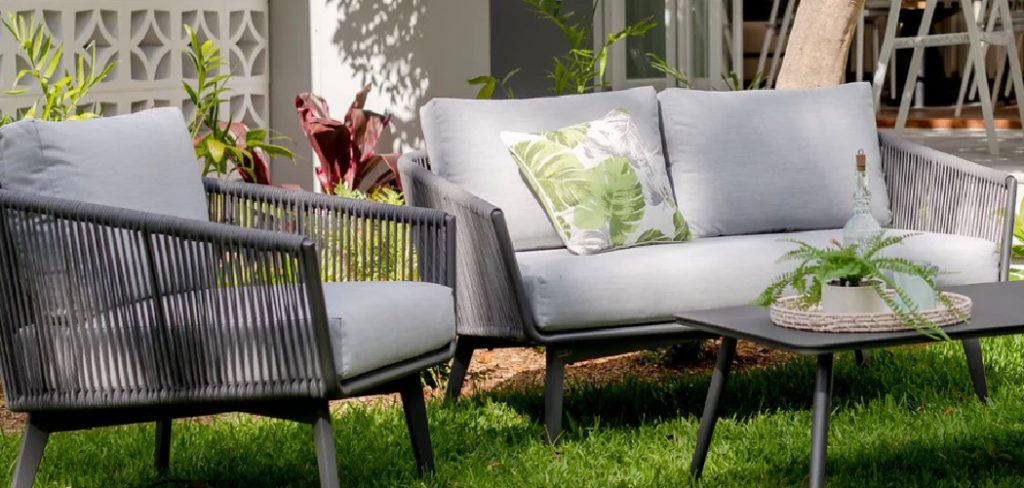
Cleaning pollen off patio furniture can be challenging, as it tends to cling to surfaces and can quickly accumulate, making your outdoor area look unkempt and potentially affecting the longevity of your furniture. In this guide, we will provide effective methods for how to clean pollen off patio furniture, including wood, metal, plastic, and fabric.
We’ll explore the best cleaning solutions, from simple soap and water to specialized cleaners, and share tips on how to prevent pollen buildup in the first place. By following these steps, you can ensure your patio furniture remains clean, attractive, and ready for use throughout the pollen season, allowing you to enjoy your outdoor spaces to the fullest.
Importance of Cleaning Pollen off Patio Furniture
Cleaning pollen off patio furniture is essential for several reasons. Firstly, accumulated pollen can create an unsightly layer on surfaces, making your outdoor space look dirty and neglected. This can detract from the aesthetic appeal of your patio and discourage you from enjoying it. Secondly, pollen can trigger allergies and respiratory issues for many people, causing discomfort and health problems when they spend time outside.
By keeping your furniture clean, you create a healthier environment for yourself and your guests. Additionally, pollen buildup can lead to the deterioration of furniture materials over time. For instance, pollen can attract moisture, leading to mold and mildew growth on fabric and wood, or it can cause metal to corrode.
Regular cleaning not only preserves the appearance of your furniture but also extends its lifespan, saving you money on potential replacements. Therefore, maintaining a routine for removing pollen is crucial for both the longevity of your outdoor furniture and the comfort and well-being of those who use it.
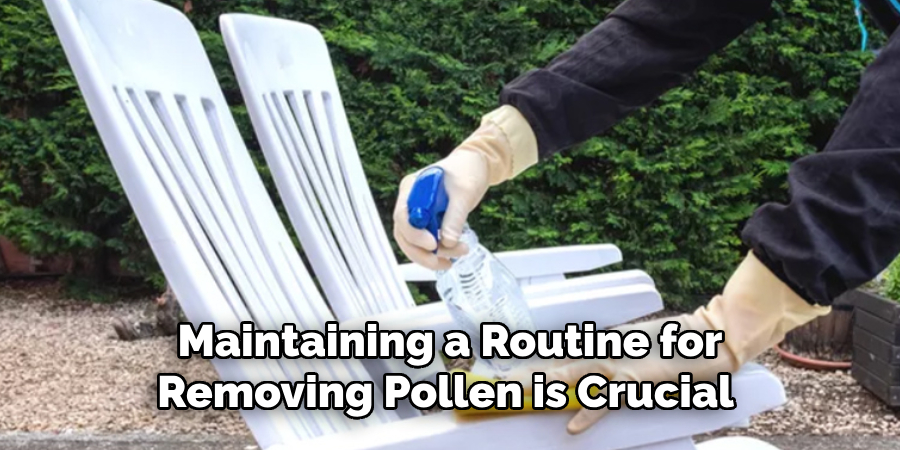
Understanding Pollen and Its Effects
Pollen is a fine powder produced by plants as part of their reproductive process. It consists of microscopic grains that can be carried by the wind, insects, or animals, thereby facilitating cross-pollination. While pollen is crucial for plant reproduction, it can be a significant nuisance when it accumulates on outdoor surfaces, particularly patio furniture.
The types of pollen vary depending on the vegetation in your area, with common sources including trees, grasses, and weeds. Each type has its own season, leading to varying levels of pollen throughout the year.
The primary effect of pollen is its potential to trigger allergic reactions in sensitive individuals. Common allergy symptoms include sneezing, itchy eyes, runny nose, and respiratory issues. For those with severe allergies, exposure to pollen can lead to more serious health problems, such as asthma attacks. Beyond health concerns, pollen can have detrimental effects on the condition of your patio furniture. Its adhesive nature allows it to build up on surfaces, fostering an environment for mold and mildew growth.
10 Methods How to Clean Pollen off Patio Furniture
Method 1: Regular Dusting and Brushing
One of the simplest ways to keep pollen off your patio furniture is through regular dusting and brushing. Using a soft-bristled brush or a microfiber duster, gently remove the pollen from the surfaces of your furniture. This method is particularly effective for routine maintenance, preventing the pollen from accumulating and becoming more difficult to remove. Regular dusting not only keeps the furniture clean but also minimizes the amount of pollen that can spread to other areas.
Method 2: Using a Leaf Blower
A leaf blower is an effective tool for removing pollen from patio furniture quickly. Set the leaf blower to a low setting to avoid damaging delicate surfaces. Blow the pollen off the furniture, starting from the top and working your way down. This method is particularly useful for larger areas or when dealing with heavy pollen deposits. It’s a quick and efficient way to clear pollen without the need for scrubbing or washing.
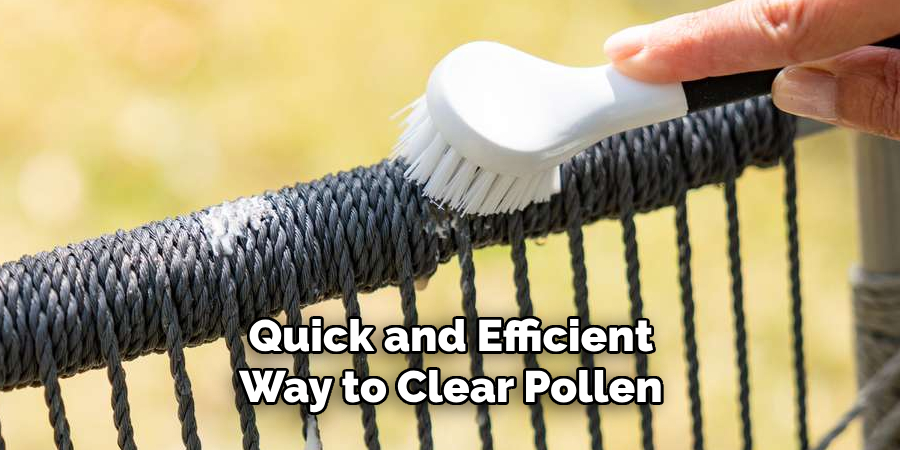
Method 3: Washing with Water
Rinsing your patio furniture with water is a straightforward method to remove pollen. Use a garden hose with a spray nozzle to wash off the pollen, starting at the top and working downwards to prevent streaks. Ensure that the water pressure is not too high to avoid damaging the furniture, especially if it is made of wood or wicker. For best results, rinse the furniture regularly during pollen season to prevent buildup.
Method 4: Mild Soap Solution
For more thorough cleaning, use a mild soap solution. Mix a few drops of dish soap with warm water in a bucket. Using a soft cloth or sponge, gently scrub the furniture to remove pollen and other dirt. Rinse the soap off with clean water and allow the furniture to dry completely. This method is effective for removing stubborn pollen and grime, leaving your patio furniture looking fresh and clean.
Method 5: Vinegar Solution
A vinegar solution is an eco-friendly and effective way to clean pollen off patio furniture. Mix equal parts white vinegar and water in a spray bottle. Spray the solution onto the furniture and let it sit for a few minutes to loosen the pollen. Wipe the furniture with a soft cloth or sponge, then rinse with water and let it dry. Vinegar not only cleans but also helps to neutralize odors and can act as a natural disinfectant.
Method 6: Pressure Washing
For heavy pollen accumulation, a pressure washer can be very effective. Use a pressure washer with a low to medium setting to avoid damaging the furniture. Hold the nozzle about a foot away from the surface and move it in a sweeping motion to remove pollen and dirt. Be cautious with delicate materials like wicker or wood, as high pressure can cause damage. Pressure washing is ideal for large areas and provides a deep clean.
Method 7: Baking Soda and Water Paste
Baking soda is a gentle abrasive that can help remove stubborn pollen stains. Make a paste by mixing baking soda with a small amount of water. Apply the paste to the affected areas with a soft cloth or sponge and gently scrub. Rinse the furniture with clean water and allow it to dry. This method is particularly useful for removing stubborn pollen spots and also helps to deodorize the furniture.
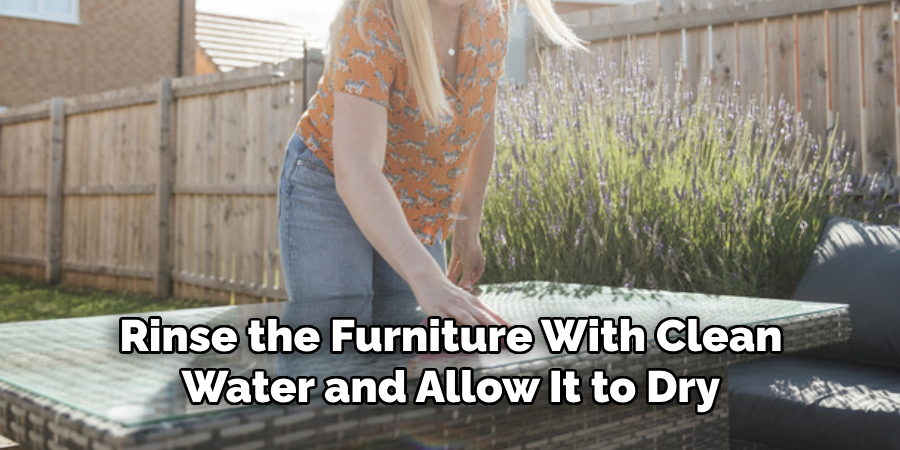
Method 8: Commercial Outdoor Furniture Cleaner
There are various commercial outdoor furniture cleaners available that are specifically formulated to remove dirt, pollen, and grime. Follow the manufacturer’s instructions for the best results. Typically, these cleaners are sprayed onto the furniture, allowed to sit for a few minutes, and then wiped off with a cloth or rinsed with water. Using a commercial cleaner can be convenient and effective, especially for heavily soiled furniture.
Method 9: Protecting with Covers
Prevention is often the best approach. Using protective covers for your patio furniture can significantly reduce the amount of pollen that settles on the surfaces. Choose covers made of durable, weather-resistant material that fit your furniture snugly. When you’re not using the furniture, keep it covered to prevent pollen accumulation. This method not only keeps your furniture clean but also extends its lifespan by protecting it from the elements.
Method 10: Regular Maintenance and Inspection
Regular maintenance and inspection of your patio furniture can help keep it in good condition and make cleaning easier. Periodically check for signs of wear and tear, such as rust, mold, or mildew, and address these issues promptly. Regularly clean your furniture, even when it doesn’t appear dirty, to prevent pollen buildup. Incorporate these inspections into your routine to ensure your furniture remains in optimal condition and ready for use at any time.
Things to Consider When Cleaning Pollen off Patio Furniture
When addressing pollen on patio furniture, it’s important to consider several factors to ensure effective and safe cleaning. The type of material your furniture is made from plays a crucial role in determining the appropriate cleaning method.
For instance, wood and wicker furniture can be more susceptible to damage from high-pressure washing or abrasive cleaners, while metal and plastic are generally more durable. Additionally, consider the level of pollen accumulation and the local climate. In regions with heavy pollen seasons, more frequent and thorough cleaning may be required.
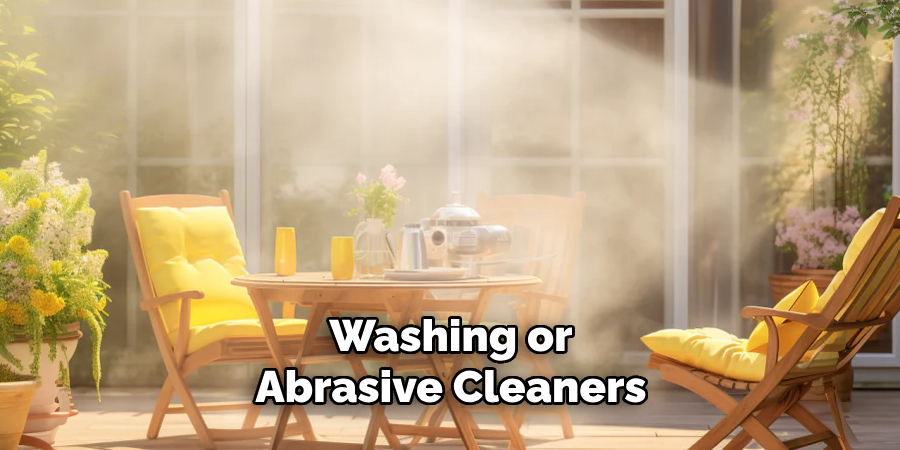
Environmental impact is another important consideration. Using eco-friendly cleaning solutions like vinegar or baking soda ensures that your cleaning efforts do not harm the surrounding plants and wildlife. Moreover, personal safety is paramount; always wear protective gear like gloves and masks to avoid allergic reactions or irritations caused by pollen and cleaning agents.
Conclusion
Maintaining clean patio furniture during pollen season requires consistent effort and the right techniques. By regularly dusting and brushing, using tools like leaf blowers and pressure washers, and employing solutions like mild soap, vinegar, and baking soda, you can effectively remove pollen and keep your outdoor space inviting.
Additionally, using commercial cleaners, protecting your furniture with covers, and adhering to regular maintenance routines will ensure your patio furniture remains in excellent condition year-round. Each method has its advantages, and a combination of several approaches may be the most effective strategy for keeping pollen at bay. Thanks for reading, and we hope this has given you some inspiration on how to clean pollen off patio furniture!
